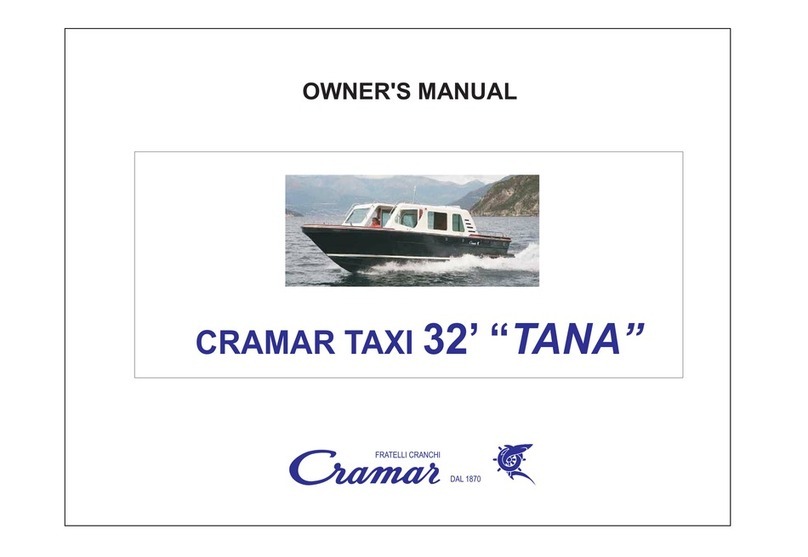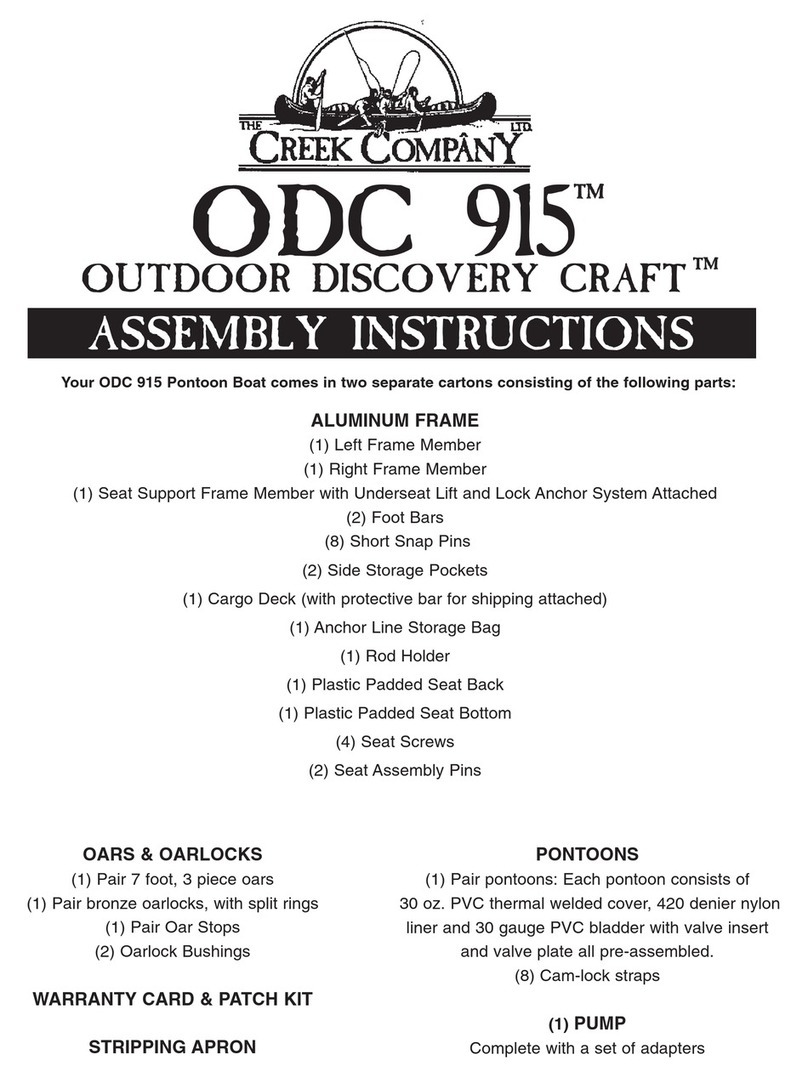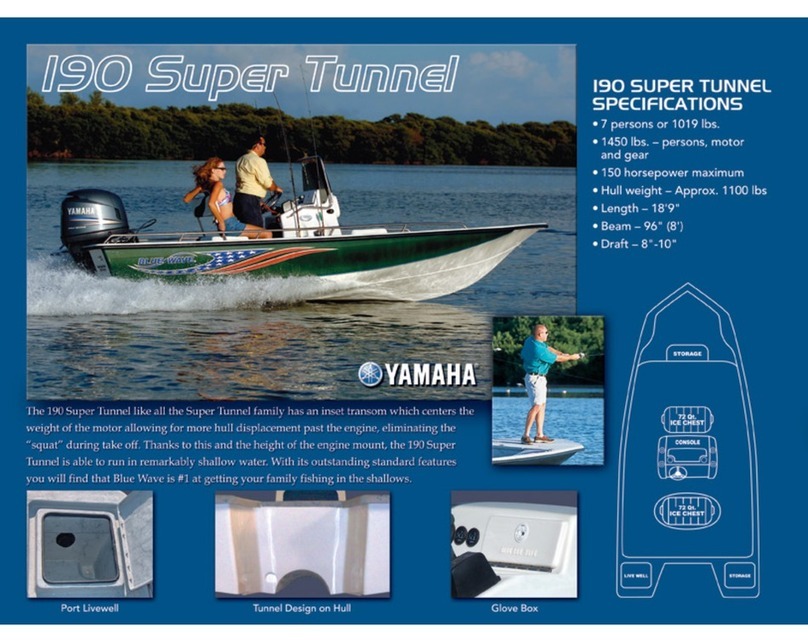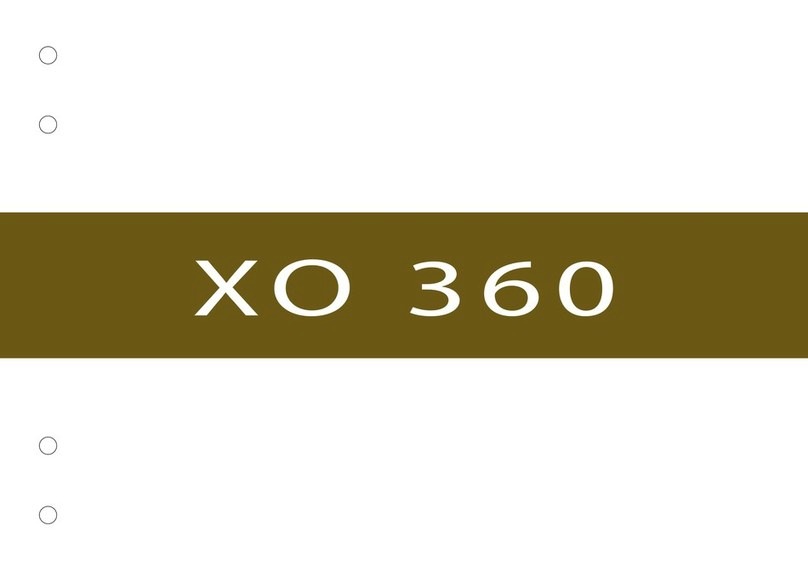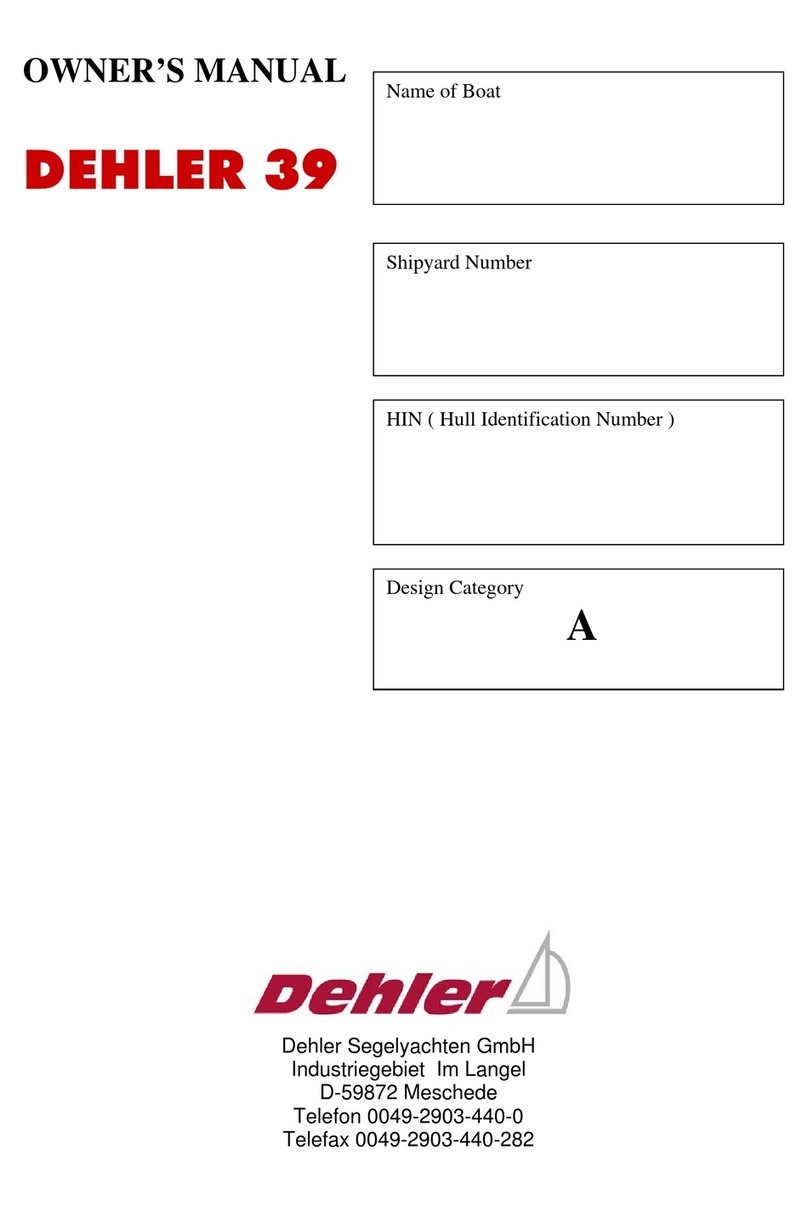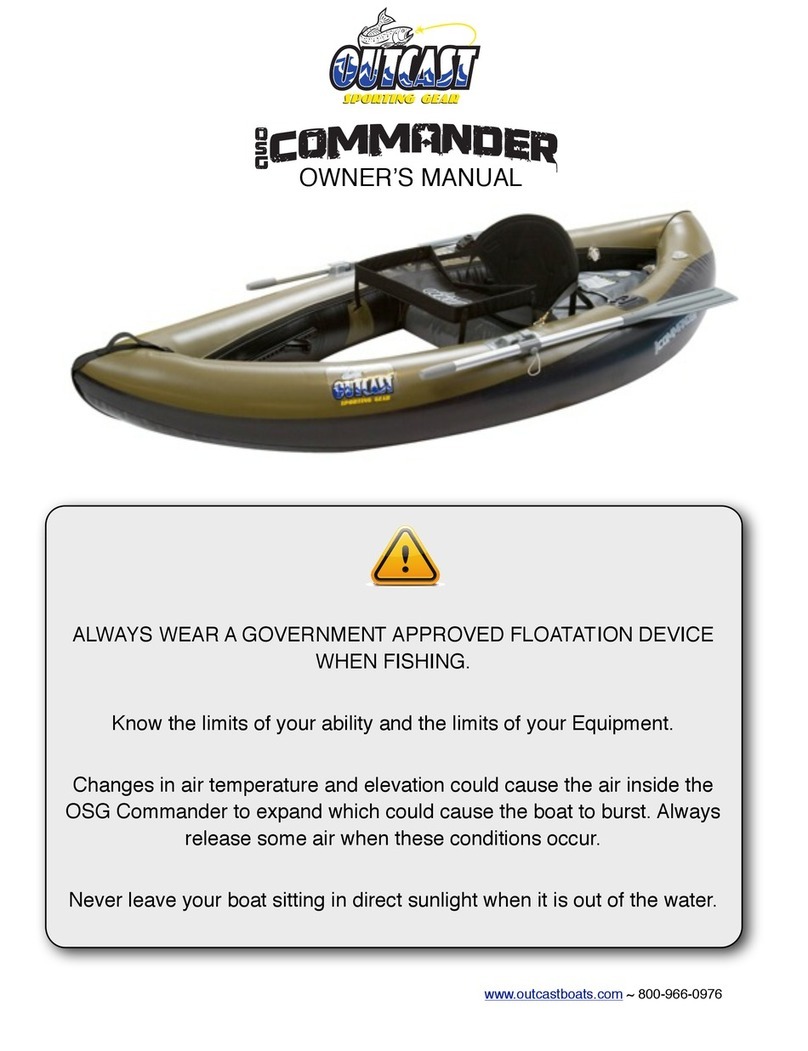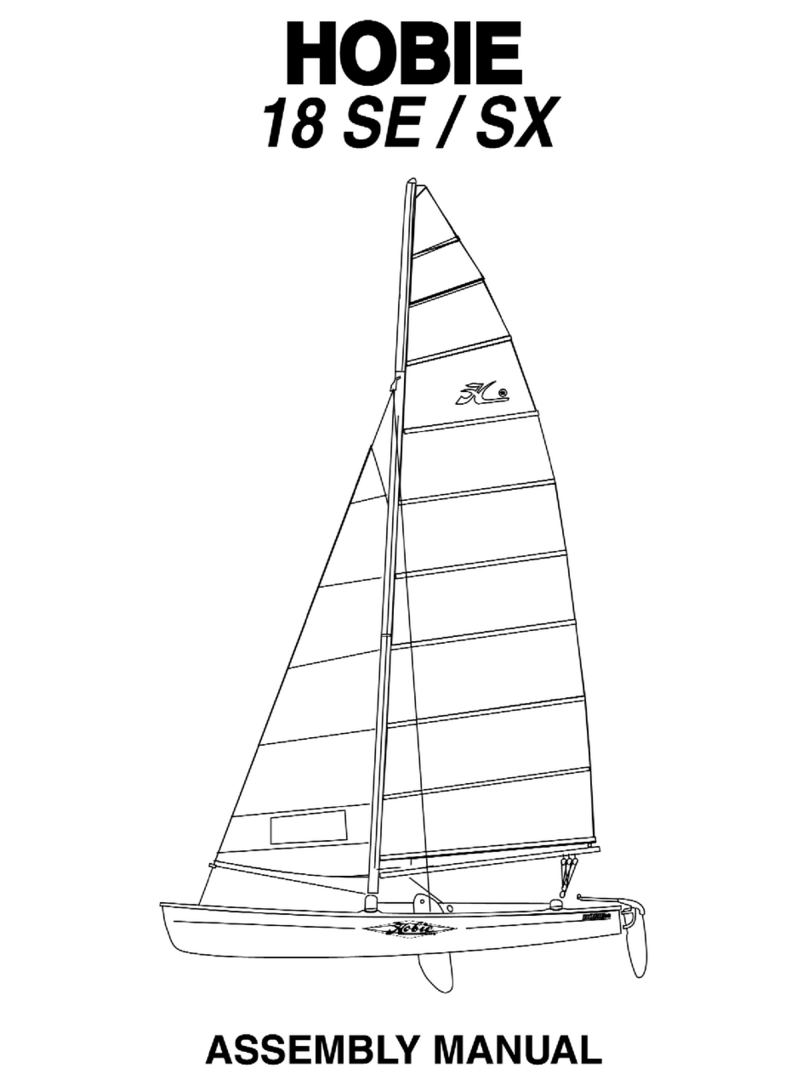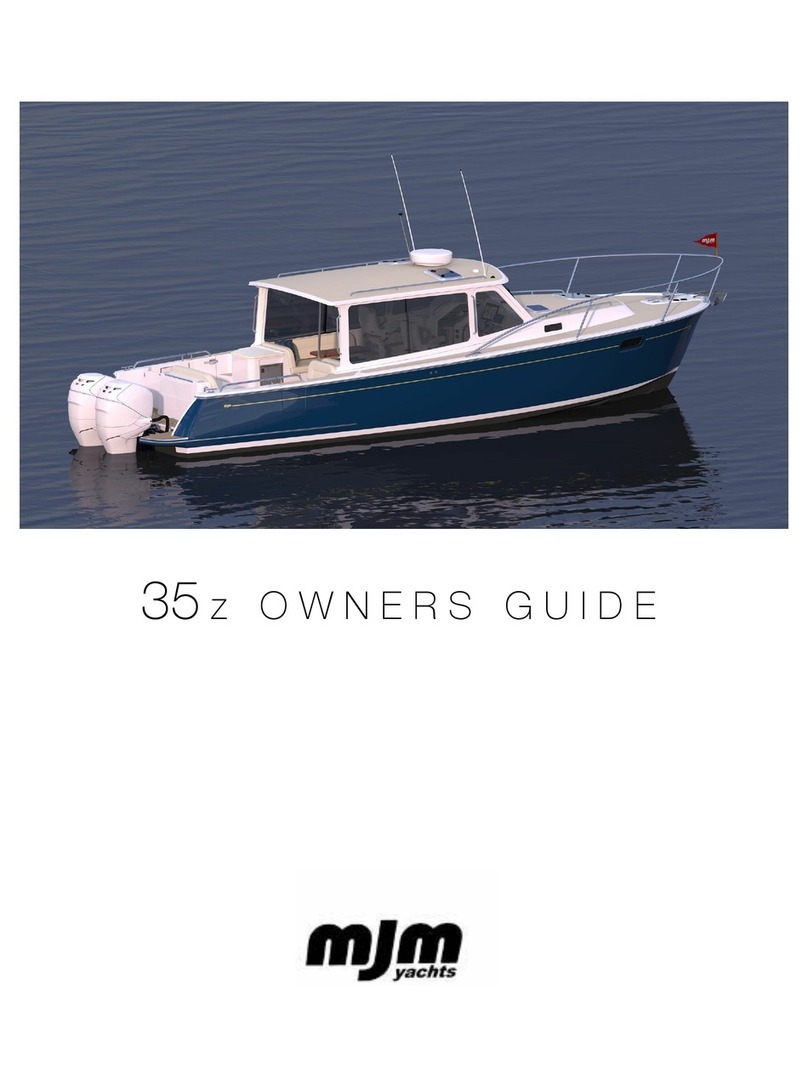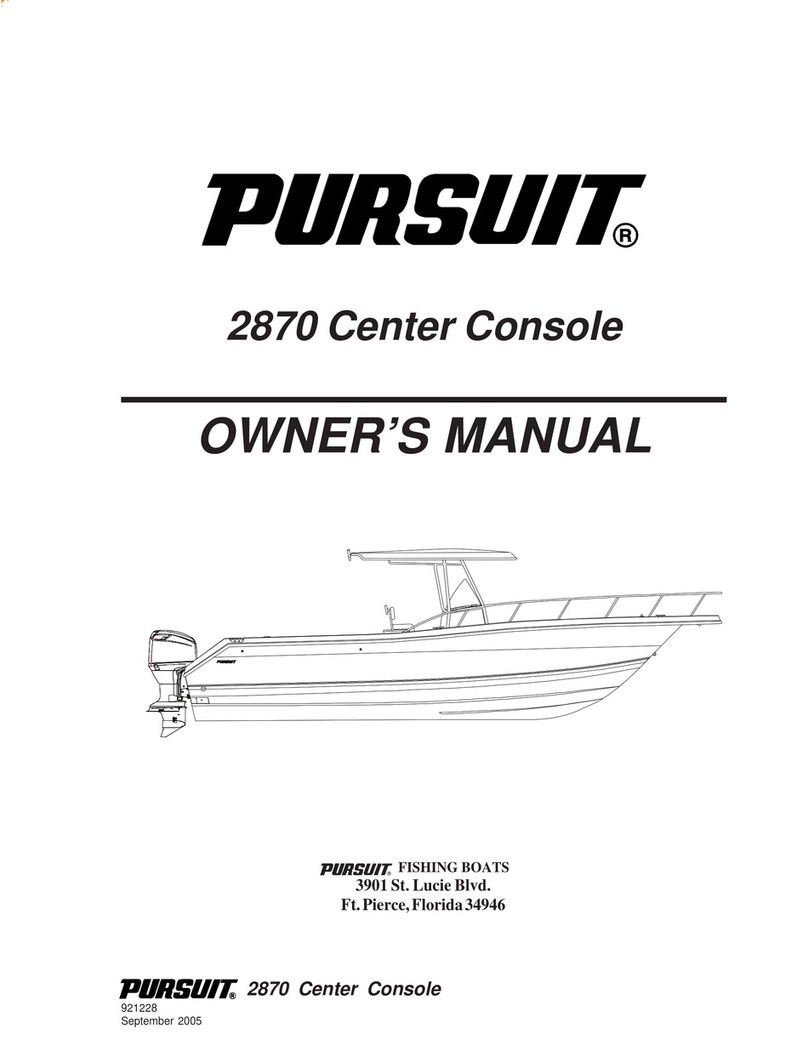Everglades 275 CC User manual

2012 Owner’s Manual
275 cc
295 cc
325 cc

2
Revision 1
10/24/2011

3
TABLE OF CONTENTS
TABLE OF CONTENTS .......................................................................................................... 3
SAFETY INFORMATION ........................................................................................................ 7
BOAT INFORMATION .......................................................................................................... 8
SPECIFICATIONS................................................................................................................ 9
CERTIFICATIONS & SPECIFICATIONS ...................................................................................12
INTRODUCTION & IMPORTANT INFORMATION .......................................................................15
OWNER / OPERATOR INFORMATION.....................................................................................17
Chapter 1:
SAFETY EQUIPMENT
1.1 General .....................................................................................................................19
1.2 Engine Alarms ............................................................................................................19
1.3 Neutral Safety Switch ..................................................................................................19
1.4 Engine Stop Switch .....................................................................................................19
1.5 Required Safety Equipment ..........................................................................................20
1.6 Bilge and Fuel Fires .....................................................................................................21
1.7 First Aid.....................................................................................................................22
1.8 Additional Safety Equipment.........................................................................................22
1.9 Caution and Warning Labels .........................................................................................23
Chapter 2:
OPERATION
2.1 General .....................................................................................................................25
2.2 Rules of the Road........................................................................................................25
2.3 Pre-Cruise Check ........................................................................................................28
2.4 Operating Your Boat ....................................................................................................29
2.5 Docking, Anchoring and Mooring ..................................................................................30
2.6 Controls, Steering or Propulsion System Failure...............................................................32
2.7 Collision.....................................................................................................................32
2.8 Grounding, Towing and Rendering Assistance..................................................................32
2.9 Flooding or Capsizing...................................................................................................33
2.10 Fishing.....................................................................................................................33
2.11 Crow’s Nest (Optional) ...............................................................................................34
2.12 Man Overboard .........................................................................................................34
2.13 Water Skiing and Wakeboarding ..................................................................................35
2.14 Teak Surng .............................................................................................................36
2.15 Trash Disposal ..........................................................................................................37
2.16 Trailering Your Boat ...................................................................................................37
Chapter 3:
PROPULSION SYSTEM
3.1 General .....................................................................................................................41
3.2 Drive System Corrosion ...............................................................................................41
3.3 Engine Lubrication.......................................................................................................42
3.4 Engine Cooling System ................................................................................................42
3.5 Propellers ..................................................................................................................42
3.6 Performance Issues and Propellers ................................................................................42
3.7 Engine Instrumentation ...............................................................................................44

4
TABLE OF CONTENTS
Chapter 4:
HELM CONTROL SYSTEMS
4.1 General .....................................................................................................................47
4.2 Engine Throttle and Shift Controls .................................................................................47
4.3 Neutral Safety Switch ..................................................................................................48
4.4 Engine Power Tilt and Trim ...........................................................................................49
4.5 Engine Stop Switch .....................................................................................................49
4.6 Steering System .........................................................................................................50
4.7 Trim Tabs ...................................................................................................................50
4.8 Bow Thruster (Optional)...............................................................................................51
4.9 Control Systems Maintenance .......................................................................................52
Chapter 5:
FUEL SYSTEM
5.1 General .....................................................................................................................55
5.2 Outboard Fuel System .................................................................................................56
5.3 Fueling Instructions.....................................................................................................57
5.4 Fuel System Maintenance.............................................................................................58
Chapter 6:
ELECTRICAL SYSTEM
6.1 General .....................................................................................................................59
6.2 DC System Overview ...................................................................................................59
6.3 Batteries and Battery Switches .....................................................................................59
6.4 DC System Switch and Circuit Breaker Panels .................................................................63
6.5 Bonding System .........................................................................................................69
6.6 AC Electrical System....................................................................................................70
6.7 Electrical System Maintenance ......................................................................................71
Chapter 7:
Fresh Water System
7.1 General .....................................................................................................................73
7.2 Fresh Water System Operation......................................................................................73
7.3 Fresh Water System Maintenance..................................................................................74
Chapter 8:
RAW WATER SYSTEM
8.1 General .....................................................................................................................77
8.2 Raw Water System Operation .......................................................................................77
8.3 Baitwell .....................................................................................................................78
8.4 Raw Water System Maintenance....................................................................................79

5
TABLE OF CONTENTS
Chapter 9:
DRAINAGE SYSTEMS
9.1 General .....................................................................................................................81
9.2 Cockpit Sole Drains ....................................................................................................81
9.3 Hardtop Drains ...........................................................................................................81
9.4 Bilge Drainage ............................................................................................................81
9.5 Fishboxes, Baitwell and Storage Compartment Drains ......................................................82
9.6 Cockpit and Water System Drains..................................................................................83
9.7 Drainage System Maintenance ......................................................................................83
Chapter 10:
VENTILATION SYSTEM
10.1 Cabin Ventilation .......................................................................................................85
10.2 Windshield Ventilation ...............................................................................................86
10.3 Bilge Ventilation ........................................................................................................86
10.4 Maintenance .............................................................................................................86
Chapter 11:
EXTERIOR EQUIPMENT
11.1 Deck Rails and Deck Hardware ....................................................................................87
11.2 275/295 Center Console Rope Locker and Windlass........................................................87
11.3 325 Center Console Rope Locker and Windlass ..............................................................88
11.4 Hull .........................................................................................................................90
11.5 Cockpit Features All Models ........................................................................................91
11.6 275/295 Center Console Cockpit Equipment..................................................................92
11.7 325 Center Console Cockpit Equipment ........................................................................98
11.8 Center Console and Helm .........................................................................................102
11.9 Hardtop ................................................................................................................105
11.10 Crow’s Nest (Optional) ...........................................................................................106
Chapter 12:
INTERIOR EQUIPMENT
12.1 275 Center Console Head Compartment .....................................................................107
12.2 295/325 Center Console Head Compartment...............................................................108
12.3 Marine Head System................................................................................................108
Chapter 13:
ROUTINE MAINTENANCE
13.1 Exterior Hull and Deck .............................................................................................111
13.2 Upholstery, Canvas and Enclosures ............................................................................114
13.3 Interior .................................................................................................................116
13.4 Bilge, Pumps and Components ..................................................................................117
13.5 Drainage System.....................................................................................................117

6
TABLE OF CONTENTS
Chapter 14:
SEASONAL MAINTENANCE
14.1 Storage and Lay-up .................................................................................................119
14.2 Winterizing.............................................................................................................121
14.3 Recommissioning ....................................................................................................123
Appendix A:
SCHEMATICS
275/295 Center Console Wiring Diagram ............................................................................125
325 Center Console Wiring Diagram...................................................................................126
Appendix B:
GLOSSARY OF TERMS ......................................................................................................127
Appendix C:
MAINTENANCE LOG .........................................................................................................131
Appendix D:
BOATING ACCIDENT REPORT ............................................................................................137
Appendix E:
FLOAT PLAN....................................................................................................................141
Appendix F:
TROUBLESHOOTING GUIDE ..............................................................................................143

7
DANGER
WARNING
CAUTION
Your Everglades owner’s manual has been written to include a number of safety instructions to assure
the safe operation and maintenance of your boat. These instructions are in the form of DANGER,
WARNING and CAUTION statements. The following denitions apply:
IMMEDIATE HAZARDS WHICH WILL RESULT IN SEVERE
PERSONAL INJURY OR DEATH.
HAZARDS OR UNSAFE PRACTICES WHICH COULD RESULT
IN SEVERE PERSONAL INJURY OR DEATH.
HAZARDS OR UNSAFE PRACTICES WHICH COULD RESULT
IN MINOR PERSONAL INJURY OR PRODUCT AND PROPERTY
DAMAGE.
All instructions given in this book are as seen from the stern looking toward the bow, with starboard
being to your right and port to your left. A glossary of boating terms is included.
IMPORTANT NOTE: Your boat uses an internal combustion engine and ammable fuel. Every pre-
caution has been taken by Everglades to reduce the risks associated with possible injury and damage
from re or explosion, but your own precaution and good maintenance procedures are necessary in
order to enjoy safe operation of your boat.
SAFETY INFORMATION

8
All information, illustrations and specications contained in this manual are based on the
latest product information available at the time of publication. Everglades Boats reserves
the right to make changes at anytime, without notice, in colors, materials, equipment,
specications and models.
Please ll out the following information section and leave it in your Everglades owner’s
manual. This information will be important for you, your dealer and/or Everglades service
personnel to know, if you may need to call them for technical assistance or service.
BOAT INFORMATION
PHONE:
REPRESENTATIVE:
NOTES
NAME:
DEALER/PHONE:
ADDRESS:
SERVICE MANAGER:
ADDRESS:
SALESMAN:
DEALER EVERGLADES
MODEL:
PURCHASE DATE:
IGNITION KEYS #:
DRAFT:
HULL SERIAL #:
DELIVERY DATE:
REGISTRATION #:
WEIGHT:
TRAILER
OPTIONS
MAKE:
PORT SERIAL #:
MODEL:
STARBOARD SERIAL #:
SERIAL #:
MAKE: MODEL:
GVWR:
PROPELLERS
MAKE:
DIAMETER/PITCH:
TIRE SIZE:
ENGINES
BLADES:
SHAFT:
BOAT
EVERGLADES E-MAIL:
DEALER E-MAIL:
BEAM: VERTICAL CLEARANCE:
DOOR KEYS #:

9
Notice:
Dry weight is the average weight of the base boat without engines, fuel, water,
waste or gear.
Specications and weights are approximate and may differ from boat to boat.
SPECIFICATIONS
275 CC Specications
HULL LENGTH OVERALL W/ ENGINE _____________________________________________________ 29’ 3”
BEAM ________________________________________________________________________________ 9’ 9”
WEIGHT DRY - NO ENGINES ____________________________________________________________ 6,000
DEAD RISE _____________________________________________________________________________ 210
DRAFT WITH ENGINES UP _______________________________________________________________ 20”
DRAFT WITH ENGINES DOWN_____________________________________________________________ 33”
TRANSOM HEIGHT ______________________________________________________________________ 25”
BRIDGE CLEARANCE TOP OF HARDTOP _____________________________________________________ 8’
FUEL CAPACITY_____________________________________________________________________ 200 gal
WATER TANK CAPACITY________________________________________________________________25 gal
WASTE TANK CAPACITY_________________________________________________________________9 gal
MAXIMUM HORSEPOWER _____________________________________________________________ 600 hp
MAXIMUM PERSONS CAPACITY ___________________________________________________________ 12
MAXIMUM PERSONS / GEAR WEIGHT _________________________________________________ 3,800 lbs
SLING LOCATIONS - AFT (inches from aft rubrail) ______________________________________________ 38”
SLING LOCATIONS - FORWARD (inches forward of aft sling location ______________________________ 128”

10
SPECIFICATIONS
295 CC Specications
Notice:
Dry weight is the average weight of the base boat without engines, fuel, water,
waste or gear.
Specications and weights are approximate and may differ from boat to boat.
HULL LENGTH OVERALL W/ ENGINE _____________________________________________________ 31’ 3”
BEAM ________________________________________________________________________________ 9’ 9”
WEIGHT DRY - NO ENGINES ____________________________________________________________ 6,300
DEAD RISE _____________________________________________________________________________ 210
DRAFT WITH ENGINES UP _______________________________________________________________ 20”
DRAFT WITH ENGINES DOWN_____________________________________________________________ 33”
TRANSOM HEIGHT ______________________________________________________________________ 25”
BRIDGE CLEARANCE TOP OF HARDTOP _____________________________________________________ 8’
FUEL CAPACITY_____________________________________________________________________ 200 gal
WATER TANK CAPACITY________________________________________________________________25 gal
WASTE TANK CAPACITY_________________________________________________________________9 gal
MAXIMUM HORSEPOWER _____________________________________________________________ 700 hp
MAXIMUM PERSONS CAPACITY ___________________________________________________________ 14
MAXIMUM PERSONS / GEAR WEIGHT _________________________________________________ 4,000 lbs
SLING LOCATIONS - AFT (inches from aft rubrail) ______________________________________________ 38”
SLING LOCATIONS - FORWARD (inches forward of aft sling location ______________________________ 144”

11
325 CC Specications
HULL LENGTH OVERALL W/ ENGINE _______________________________________________________ 35’
BEAM _______________________________________________________________________________ 10’ 8”
WEIGHT DRY - NO ENGINES ____________________________________________________________ 9,000
DEAD RISE _____________________________________________________________________________ 250
DRAFT WITH ENGINES UP _______________________________________________________________ 24”
DRAFT WITH ENGINES DOWN_____________________________________________________________ 36”
TRANSOM HEIGHT ______________________________________________________________________ 30”
BRIDGE CLEARANCE TOP OF HARDTOP ___________________________________________________8’ 9”
FUEL CAPACITY_____________________________________________________________________ 327 gal
WATER TANK CAPACITY________________________________________________________________35 gal
WASTE TANK CAPACITY_________________________________________________________________9 gal
MAXIMUM HORSEPOWER _____________________________________________________________ 700 hp
MAXIMUM PERSONS CAPACITY ___________________________________________________________ 14
MAXIMUM PERSONS / GEAR WEIGHT _________________________________________________ 5,200 lbs
SLING LOCATIONS - AFT (inches from aft rubrail) ______________________________________________ 57”
SLING LOCATIONS - FORWARD (inches forward of aft sling location ______________________________ 150”
Notice:
Dry weight is the average weight of the base boat without engines, fuel, water,
waste or gear.
Specications and weights are approximate and may differ from boat to boat.
SPECIFICATIONS

12
CERTIFICATIONS & SPECIFICATIONS
275 Center Console
Export Documentation
(For Export Only)
To be in compliance with European directives for recreational boats as published by the
International Organization for Standardization (ISO) in effect at the time this boat was
manufactured, we are providing the following information.
Manufacturer:
Name Everglades Boats
544 Air Park Road
Edgewater, FL Zip Code: 32132
Identication Numbers:
Hull Identication Number
Engine Serial Number
Intended Design Category:
Ocean (Cat A) Inshore (Cat C)
Offshore (Cat B) Sheltered Waters (Cat D)
Weight and Maximum Capacities:
Unladen Weight - Kilograms (Pounds)
Maximum Load - Weight- Kilograms (Pounds)
Number of People
Maximum Rated Engine Horsepower - Kilowatts (Horsepower)
Certications:
Certications & Components Covered
See Declaration of Conformity

13
CERTIFICATIONS & SPECIFICATIONS
(For Export Only)
To be in compliance with European directives for recreational boats as published by the
International Organization for Standardization (ISO) in effect at the time this boat was
manufactured, we are providing the following information.
Manufacturer:
Name Everglades Boats
544 Air Park Road
Edgewater, FL Zip Code: 32132
Identication Numbers:
Hull Identication Number
Engine Serial Number
Intended Design Category:
Ocean (Cat A) Inshore (Cat C)
Offshore (Cat B) Sheltered Waters (Cat D)
Weight and Maximum Capacities:
Unladen Weight - Kilograms (Pounds)
Maximum Load - Weight- Kilograms (Pounds)
Number of People
Maximum Rated Engine Horsepower - Kilowatts (Horsepower)
Certications:
Certications & Components Covered
See Declaration of Conformity
295 Center Console
Export Documentation

14
CERTIFICATIONS & SPECIFICATIONS
325 Center Console
Export Documentation
(For Export Only)
To be in compliance with European directives for recreational boats as published by the
International Organization for Standardization (ISO) in effect at the time this boat was
manufactured, we are providing the following information.
Manufacturer:
Name Everglades Boats
544 Air Park Road
Edgewater, FL Zip Code: 32132
Identication Numbers:
Hull Identication Number
Engine Serial Number
Intended Design Category:
Ocean (Cat A) Inshore (Cat C)
Offshore (Cat B) Sheltered Waters (Cat D)
Weight and Maximum Capacities:
Unladen Weight - Kilograms (Pounds)
Maximum Load - Weight- Kilograms (Pounds)
Number of People
Maximum Rated Engine Horsepower - Kilowatts (Horsepower)
Certications:
Certications & Components Covered
See Declaration of Conformity

15
All instructions given in this book are as seen from
the stern looking toward the bow with starboard
being to your right and port to your left. The
information and precautions listed in this manual
are not all inclusive. It may be general in nature in
some cases and detailed in others and is designed
to provide you a basic understanding of your
Everglades boat and some of the responsibilities
that go along with owning/operating your boat.
The suppliers of some of the major components
such as the engines, pumps and appliances,
provide their own owner’s manuals which have
been included with your boat. You should read
the information in this manual and the manuals of
other suppliers completely and have a thorough
understanding of all component systems and their
proper operation before operating your boat.
REMEMBER - IT IS YOUR RESPONSIBILITY TO ENSURE THAT
YOUR BOAT IS SAFE FOR YOU AND YOUR PASSENGERS.
ALWAYS EXERCISE GOOD COMMON SENSE WHEN INSTALLING
EQUIPMENT AND OPERATING THE BOAT.
Warranty and Warranty Registration Cards
The Everglades Limited Warranty Statement is in-
cluded with your boat. It has been written to be
clearly stated and easily understood. If you have any
questions after reading the warranty, please contact
the Everglades Boats Customer Service Department
Everglades, engine manufacturers and the sup-
pliers of major components maintain their own
manufacturer’s warranty and service facilities. It is
important that you properly complete the warranty
registration cards included with your boat and engine
and mail them back to the manufacturer to register
your ownership. This should be done within 15 days
of the date of purchase and before the boat is put
into service. A form for recording this information
for your records is provided at the beginning of this
manual. This information will be important for you
and service personnel to know, if and when you may
need service or technical information.
The boat warranty registration requires the Hull
Identication Number “HIN” which is located on
the starboard side of the transom, just below the
rubrail. The engine warranty registration requires
the engine serial numbers. Please refer to the en-
gine owner’s manual for the location of the serial
numbers.
IMPORTANT:
The terms and conditions of the Everglades Boats
Limited Warranty are outlined in the warranty
statement included in this manual. The manu-
facturer will automatically honor the warranty to
the original purchaser for 15 days from the date
of purchase. However, during that 15 day period,
owners must comply with the steps outlined in
the warranty statement to validate their warranty.
All boat manufacturers are required by the Federal
Boat Safety Act of 1971 to notify rst time own-
ers in the event any defect is discovered “which
creates a substantial risk of personal injury to
the public.” It is essential that we have your
warranty registration card complete with
your name and mailing address in our les so
that we can comply with the law if it should
become necessary.
Your Everglades Boats Dealer will assist you in
lling in the hull number and other data required
on your Registration Card. Check to see that your
card is complete and signed. Detach and mail.
Your Warranty Registration Card will be added to
our permanent les.
INTRODUCTION & IMPORTANT INFORMATION
Hull ID # On Starboard Side of Transom

16
Transferring the Limited Structural Warranty
For a transfer fee, Everglades Boats will offer to
extend a Transferable Limited Structural Hull War-
ranty to subsequent owners of Everglades Boats.
Please refer to the Everglades Limited Warranty
Statement for the terms and conditions of the
Transferable Limited Structural Hull Warranty and
the procedure to transfer the warranty.
Product Changes
Everglades is committed to the continuous im-
provement of our boats. As a result, some of the
equipment described in this manual or pictured in
the catalog may change or no longer be available.
All information, illustrations and specica-
tions contained in this manual are based on
the latest product information available at
the time of publication. Everglades Boats
reserves the right to make changes at any-
time, without notice, in colors, materials,
equipment, specications and models. If
you have questions about the equipment on your
Everglades, please contact the Everglades Boats
Customer Service Department.
Service
All warranty repairs must be performed by an
authorized Everglades Dealer. Should a problem
develop that is related to faulty workmanship or
materials, as stated in the Limited Warranty, you
should contact your Everglades dealer to arrange
for the necessary repair. If you are not near your
dealer or another authorized Everglades dealer
or the dealer fails to remedy the cause of the
problem, then contact Everglades within 15 days.
Everglades will not reimburse boat owners
for warranty repairs performed without prior
authorization provided in writing.
It is the boat owner’s responsibility to deliver
the boat to the dealer for warranty service.
INTRODUCTION & IMPORTANT INFORMATION

17
Registration and Numbering
Federal law requires that all undocumented ves-
sels equipped with propulsion machinery be regis-
tered in the State of principal use. A certicate of
number will be issued upon registering the boat.
These numbers must be displayed on your boat.
The owner/operator of a boat must carry a valid
certicate of number whenever the boat is in use.
When moved to a new State of principal use, the
certicate is valid for 60 days.
In order to be valid, the numbers must be installed
to the proper specications. Check with your
dealer or state boating authority for numbering
requirements. The Coast Guard issues the cer-
ticate of number in Alaska; all others are issued
by the state.
Insurance
In most States the boat owner is legally respon-
sible for damages or injuries he or someone else
operating the boat causes. Responsible boaters
carry adequate liability and property damage in-
surance for their boat. You should also protect the
boat against physical damage and theft. Some
States have laws requiring minimum insurance
coverage. Contact your dealer or state boating
authority for information on the insurance require-
ments in your boating area.
Reporting Boating accidents
All boating accidents must be reported by the op-
erator or owner of the boat to the proper marine
law enforcement authority for the state in which
the accident occurred. Immediate notication is
required if a person dies or disappears as a result
of a recreational boating accident.
If a person dies or there are injuries requiring
more than rst aid, a formal report must be led
within 48 hours.
A formal report must be made within 10 days for
accidents involving more than $500.00 damage
or the complete loss of a boat.
A Boating Accident Report form is located near
the back of this manual to assist you in reporting
an accident. If you need additional information
regarding accident reporting, please call the Boat-
ing Safety Hotline, 800-368-5647.
Education
If you are not an experienced boater, we recom-
mend that the boat operator and other people
that normally accompany the operator, enroll in a
boating safety course. Organizations such as the
U.S. Power Squadrons, United States Coast Guard
Auxiliary, State Boating Authorities and the Ameri-
can Red Cross offer excellent boating educational
programs. These courses are worthwhile even for
experienced boaters to sharpen your skills or bring
you up to date on current rules and regulations.
They can also help in providing local navigational
information when moving to a new boating area.
Contact your dealer, State Boating Authority or the
Boating Safety Hotline, 800-368-5647 for further
information on boating safety courses.
Required Equipment
U.S. Coast Guard regulations require certain
equipment on each boat. The Coast Guard also
sets minimum safety standards for vessels and
associated equipment. To meet these standards
some of the equipment must be Coast Guard ap-
proved. “Coast Guard Approved Equipment” has
been determined to be in compliance with USCG
specications and regulations relating to perfor-
mance, construction or materials. The equipment
requirements vary according to the length, type
of boat and the propulsion system. Some of the
Coast Guard equipment is described in the Safety
Equipment chapter of this manual. For a more
detailed description, obtain “Federal Requirements
And Safety Tips For Recreational Boats” by con-
tacting the Boating Safety Hotline 800-368-5647
or your local marine dealer or retailer.
Some state and local agencies impose similar
equipment requirements on waters that do not fall
under Coast Guard jurisdiction. These agencies
may also require additional equipment that is not
required by the Coast Guard. Your dealer or local
boating authority can provide you with additional
information for the equipment requirements for
your boating area.
OWNER / OPERATOR INFORMATION

18
THIS PAGE WAS LEFT BLANK
INTENTIONALLY

19
SAFETY EQUIPMENT
1.1 General
Your boat and outboard engines have been
equipped with safety equipment designed to en-
hance the safe operation of the boat and to meet
U.S. Coast Guard safety standards. The Coast
Guard or state, county and municipal law enforce-
ment agencies require certain additional accessory
safety equipment on each boat. This equipment
varies according to length and type of boat and
type of propulsion. The accessory equipment typi-
cally required by the Coast Guard is described in
this chapter. Some local laws require additional
equipment. It is important to obtain “Federal
Requirements And Safety Tips for Recreational
Boats,” published by the Coast Guard and copies
of state and local laws, to make sure you have the
required equipment for your boating area.
Your boat is equipped with engine alarms. The
alarm systems are designed to increase your boat-
ing safety by alerting you to potentially serious
problems in the primary power system. Alarm
systems are not intended to lessen or replace good
maintenance and Pre-Cruise procedures.
This chapter also describes safety related equip-
ment that could be installed on your boat. This
equipment will vary depending on the type of
engines and other options installed by you or
your dealer.
1.2 Engine Alarms
Most outboard engines are equipped with an au-
dible alarm system mounted in the helm area that
monitors selected critical engine systems. The
alarm will sound if one of these systems begins to
fail. Refer to the engine owner’s manual for infor-
mation on the alarms installed with your engines.
If the alarm sounds:
• Immediately throttle the engines back to idle.
• Shift the transmissions to neutral.
• Monitor the engine gauges to determine the
cause of the problem.
• If necessary, shut off the engine and investigate
until the cause of the problem is found.
1.3 Neutral Safety Switch
Every control system has a neutral safety switch
incorporated into it. This device prohibits the
engines from being started while the shift levers
are in any position other than the neutral position.
If an engine will not start, slight movement of the
shift lever may be necessary to locate the neutral
position and disengage the safety cutout switch.
Control adjustments may be required to correct
this condition should it persist. See your Ever-
glades dealer for necessary control adjustments.
Please refer to the Helm Control Systems chapter
for more information on the neutral safety switch.
1.4 Engine Stop Switch
Your boat is equipped with a engine stop switch
and lanyard. When the lanyard is pulled it will
engage the switch and shut off the engines. We
strongly recommend that the lanyard be attached
to the driver and the stop switch whenever the
engines are running. If the engines will not start,
it could be because the lanyard is not properly in-
serted into the engine stop switch. Always make
sure the lanyard is properly attached to the engine
stop switch before attempting to start the engine.
Notice:
In some states, a lanyard attached to the
driver at all times is required by law.
Throwable Device and Personal PFD
Chapter 1:

20
Safety Equipment
WARNING
Notice:
You should carry an extra stop switch lan-
yard and instruct at least one other crew
member on the operation of the stop switch
and location of the extra lanyard.
1.5 Required Safety Equipment
Besides the equipment installed on your boat by
Everglades, certain other equipment is required
by the U.S. Coast Guard to help ensure pas-
senger safety. Items like a sea anchor, working
anchor, extra dock lines, are pistol, life vests,
a line permanently secured to your ring buoy,
etc., could at some time save your passengers’
lives or save your boat from damage. Refer to
the “Federal Requirements And Safety Tips For
Recreational Boats” pamphlet for a more detailed
description of required equipment. You also can
contact the U.S. Coast Guard Boating Safety
Hotline, 800-368-5647, for information on boat
safety courses and brochures listing the Federal
equipment requirements. Also, check your local
and state regulations.
The Coast Guard Auxiliary offers a “Courtesy Ex-
amination.” This inspection will help ensure that
your boat is equipped with all of the necessary
safety equipment. The following is a list of the
accessory equipment required on your boat by the
U.S. Coast Guard:
Personal Flotation Devices (PFDs)
PFDs must be Coast Guard approved, in good
and serviceable condition and of appropriate size
for the intended user. Wearable PFDs must be
readily accessible, meaning you must be able to
put them on in a reasonable amount of time in
an emergency. Though not required, the Coast
Guard emphasizes that PFDs should be worn at
all times when the vessel is underway. Throwable
devices must be immediately available for use. All
Everglades boats must be equipped with at least
one Type I, II or III PFD for each person on board,
plus one throwable device (Type IV).
Notice:
Many state laws now require that children
13 years old and under must wear a PFD at
all times.
Anyone being towed on skis, wakeboards and
other water sports equipment is considered
a passenger on the boat and must wear a
Coast Guard approved life jacket at all times.
Visual Distress Signals
All boats used on coastal waters, the Great Lakes,
territorial seas and those waters connected di-
rectly to them, must be equipped with Coast Guard
approved visual distress signals. These signals
are either Pyrotechnic or Non-Pyrotechnic devices.
Pyrotechnic Visual Distress Signals:
Pyrotechnic visual distress signals must be Coast
Guard approved, in serviceable condition and
readily accessible. They are marked with a date
showing the service life, which must not have
expired. A minimum of three are required. Some
pyrotechnic signals meet both day and night use
requirements. They should be stored in a cool,
dry location. They include:
• Pyrotechnic red ares, hand held or aerial.
• Pyrotechnic orange smoke, hand-held or
oating.
• Launchers for aerial red meteors or parachute
ares.
PYROTECHNICS ARE UNIVERSALLY RECOGNIZED AS
ExCELLENT DISTRESS SIGNALS. HOWEVER, THERE IS
POTENTIAL FOR INJURY AND PROPERTY DAMAGE IF NOT
PROPERLY HANDLED. THESE DEVICES PRODUCE A VERY
HOT FLAME AND THE RESIDUE CAN CAUSE bURNS AND
IGNITE FLAMMAbLE MATERIAL. PISTOL LAUNCHED AND
HAND-HELD PARACHUTE FLARES AND METEORS HAVE MANY
CHARACTERISTICS OF A FIREARM AND MUST bE HANDLED
WITH CAUTION. IN SOME STATES THEY ARE CONSIDERED
A FIREARM AND PROHIbITED FROM USE. ALWAYS bE
ExTREMELY CAREFUL AND FOLLOW THE MANUFACTURER’S
INSTRUCTIONS ExACTLY WHEN USING PYROTECHNIC
DISTRESS SIGNALS.
Non-Pyrotechnic Devices
Non-Pyrotechnic visual distress signals must be
in serviceable condition, readily accessible and
certied by the manufacturer as complying with
U.S. Coast Guard requirements. They include:
• Orange Distress Flag (Day use only)
The distress ag is a day signal only. It must
be at least 3 x 3 feet with a black square and
ball on an orange background. It is most
distinctive when attached and waved from a
paddle or boat hook.
This manual suits for next models
9
Table of contents
Other Everglades Boat manuals

Everglades
Everglades 340 DC User manual
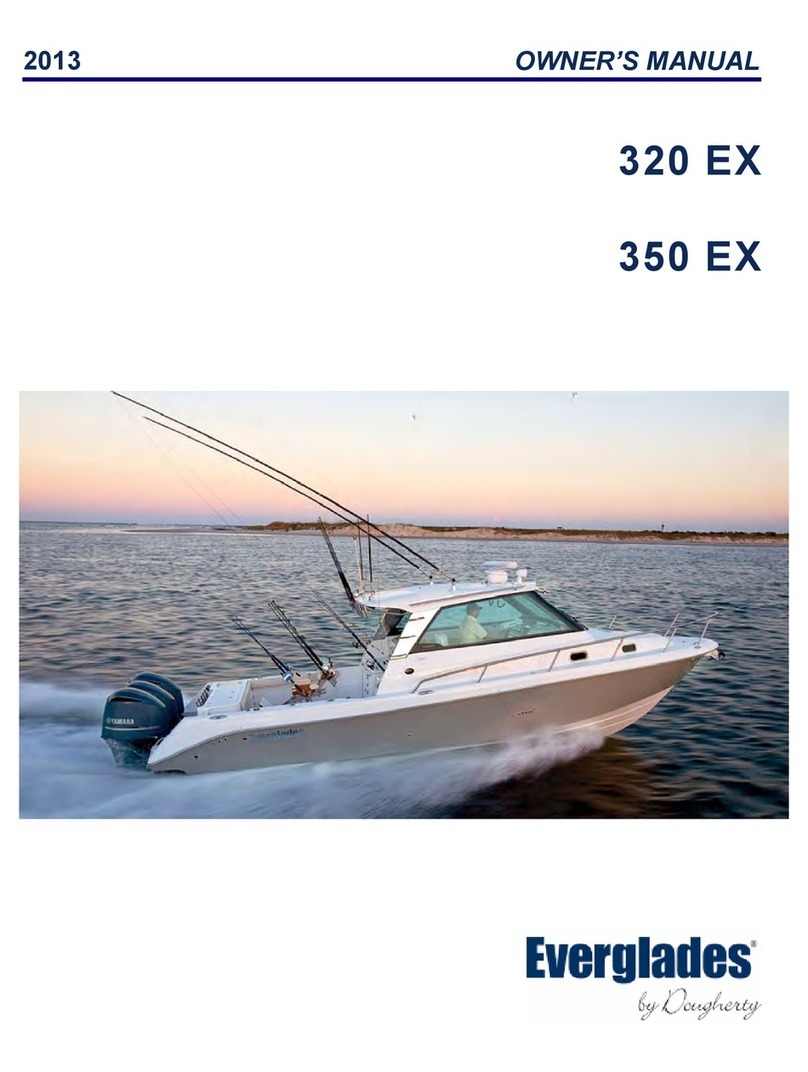
Everglades
Everglades 320 EX User manual

Everglades
Everglades 435 CC User manual

Everglades
Everglades 455 CC User manual
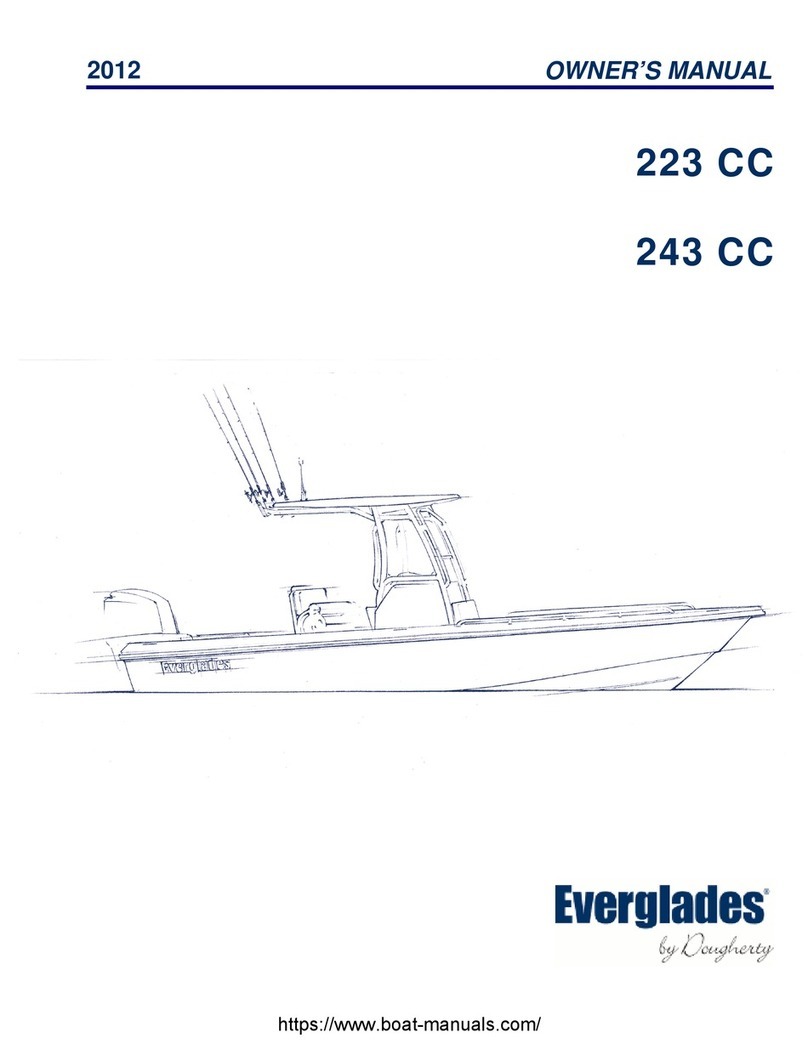
Everglades
Everglades CC 243 2012 User manual
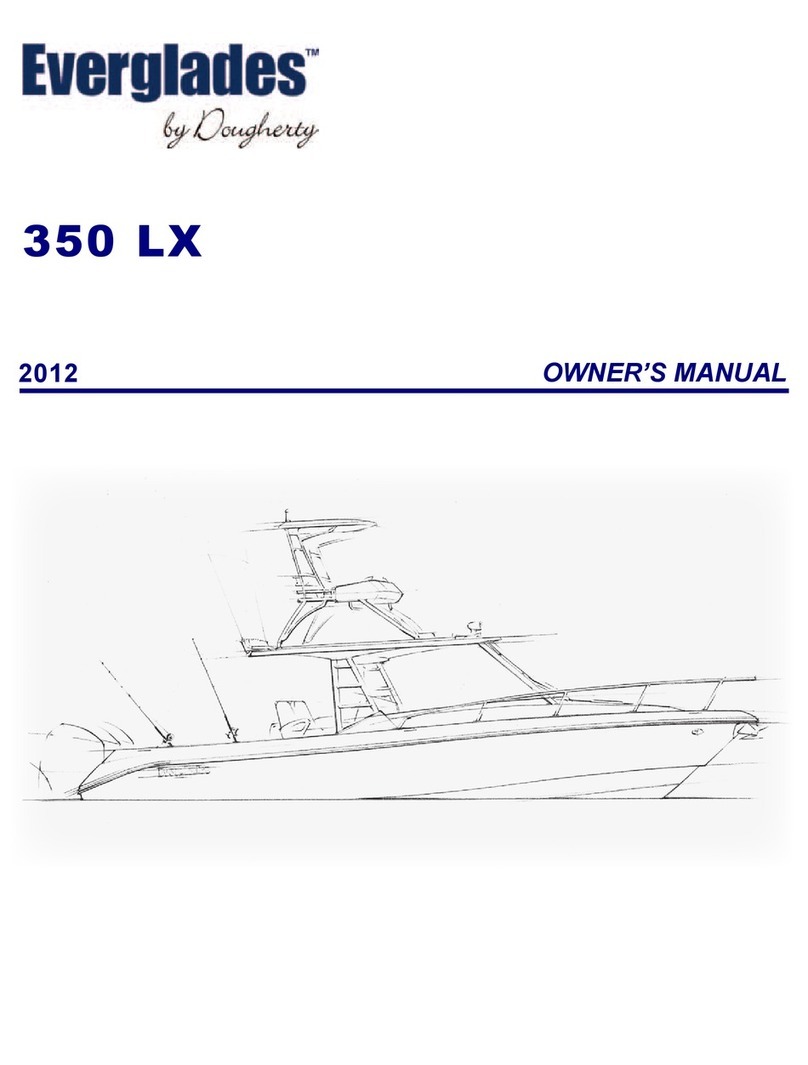
Everglades
Everglades 350 LX 2012 User manual

Everglades
Everglades 230 DC 2012 User manual

Everglades
Everglades 355 CC User manual

Everglades
Everglades 210 CC 2012 User manual

